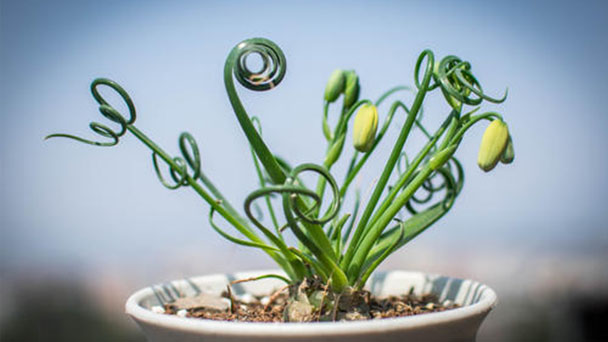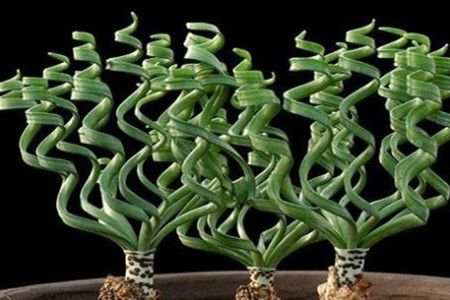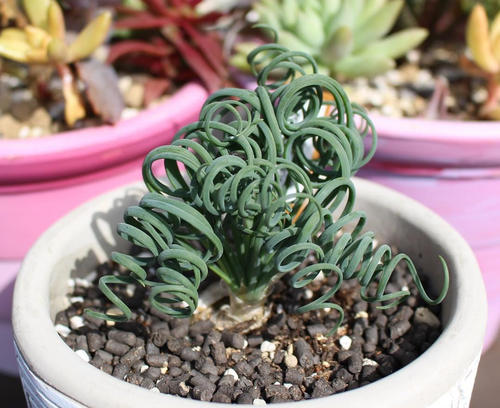Albuca Namaquensis Baker Profile
Written by Lisa
Oct 19 2021

Albuca Namaquensis Baker Picture

Albuca namaquensis Baker (Spiral Grass) Morphological Characteristics
Albuca namaquensis Baker (albuca spiral) is a perennial bulbous succulent plant with a height of 30 cm. The plant has round or irregular bulbs, with a single diameter of about 2-6 cm. The epidermis of the underground part of the bulb is yellow-white, and the exposed soil surface is divided into green.
The fleshy leaves grow from the top of the bulb, linear, thin at the tip, smooth or with white burrs on the surface. The albuca namaquensis baker leaves grow upright first, then gradually twist and circle, causing the tip of the leaf to be spring-like.
The peduncle of Albuca namaquensis Baker (albuca spiral) is very long, drawn from the leaves, the flower buds are yellow-green, racemes, and the small flowers are drooping. The petals are light yellow on the front and yellow-green on the back, with a delicate fragrance. The flower opens when the sun is full and closes in the evening. If it encounters rainy days or insufficient sunlight, it will not bloom. The flowering period is March-April.
Albuca namaquensis Baker Growth Environment and Distribution
Albuca namaquensis Baker (albuca spiral) likes a cool, humid and sunny environment, is afraid of heat and humidity, is resistant to half shade, and is also resistant to drought. It has a certain degree of cold resistance. albuca namaquensis Baker has the habit of high temperature dormancy in summer and growth in the cold season from autumn to spring.
The growth period is from September to April of the following year. In winter, the temperature should be maintained at 10°C to 20°C. Albuca namaquensis Baker (albuca spiral) can continue to grow in this environment and normal fertilizer and water management can be carried out. If the watering is controlled to make the plants dormant, it can survive the winter safely indoors at no lower than 0℃.
Albuca namaquensis Baker (albuca spiral) is mainly distributed in the eastern, western and southern parts of the Cape Province in southern Africa and Namibia.

Ornamental Value of Albuca namaquensis Baker
Since its spread all over the world, Albuca namaquensis Baker (Spiral Grass) has become a model of gardening and home planting. It is regarded as a treasure of indoor foliage flowers and is deeply loved by flower lovers all over the world. Albuca namaquensis Baker has a unique shape, rapid growth and reproduction, and beautiful appearance. Albuca namaquensis Baker is one of the most ideal plants in the potted house and a good material for making and decorating bonsai.
Albuca Frizzle Sizzle Plant Care
In the process of Albuca Frizzle sizzle plant care, it is best to give sufficient sunlight to the plants every day. In the case of high temperatures in summer, the plants should be moved to the ventilated shade. Watering should be done to keep the soil always moist without water, drainage should be done in the rainy season, and the liquid or compound fertilizer should be applied once a month in the bloom period.1. Environmental management
Albuca frizzle sizzle plant (Albuca namaquensis Baker) is a very bright light plant, grow in the cool environment faster, in addition to the summer shade does not need to handle during curing, in other seasons to make sure you get enough sun exposure, or you will make the blade thin, but under the condition of high temperature to plant in a cool ventilated place, avoid high temperature and strong sunlight, lead to tip withered.2. Water Care
The Albuca frizzle sizzle plant (Albuca namaquensis Baker) likes to grow in a moist substrate. During the growth period, the soil should always be kept moist without water. When the temperature is high, spray water around the plant to increase the air humidity so as not to dry the leaves.3. Fertilize regularly
Regular fertilization is one of the breeding methods and precautions of the albuca frizzle sizzle plant. The Albuca Frizzle sizzle plant grows and flourishes under the condition of sufficient nutrients, which can be ensured from late autumn to early spring every year. Liquid fertilizer or compound fertilizer can be applied once a month.4. Change basins
The Albuca Frizzle sizzle plant (Albuca namaquensis Baker) is usually done in the fall of each year. The rotten roots should be cut off when the plant is replaced, and the bulbs should be exposed to a third of the earth when the plant is replanted. After pouring into a permeable water, the plant can be preserved in a sunny place.5. Disease and insect prevention
The Albuca Frizzle sizzle plant (Albuca namaquensis Baker) in a poorly ventilated environment is prone to breed the harm of diseases and insects, the most common are snails and nematodes, etc. The indoor ventilation and permeability should be enhanced during the usual curing period, and some carbofuran and other insecticidal pesticides can be embedded in the soil, after which proper soil replacement treatment is required.
Albuca namaquensis Baker Propagation
The usual propagation of albuca spiral grass mainly include sowing, plant separation and cutting, etc. The seeds collected shall be immersed in the process of accelerating the bud processing during sowing, and then placed in the sand to protect the water respectively. The albuca spiral grass shall germinate in about one month.
1. Seeds Propagation
Albuca Spiral Grass is suitable for seeding propagation method. First, the seeds are collected in the mature season, the impurities are cleaned in time, and the seeds are soaked in warm water at 30 ° C for several hours. Then, the seeds are gradually absorbed and expanded, and then scattered in the soil.
2. Points Strains Propagation
When plant splitting is adopted, it can be carried out in combination with basin changing treatment in spring and autumn. After the larger bulbs are taken out, the small bulbs with dense growth above should be cut off completely, disinfected and dried, and then placed in the prepared nutrient soil. After pouring into a permeable water, the soil in the basin should be kept moist, and the real leaves of albuca spiral grass should be transplanted after being unearthed.
3. Cutting Propagation
Cutting is one of the propagation methods for albuca spiral grass. In the peak season, the perennial and robust stem part can be selected as the cuttings, and its base can be cut into a smooth inclined shape. After being treated with appropriate gibberellin solution, it can be directly inserted into the wet sand, and the germination will be about 20 days after being watered.
4. Notes
When albuca spiral grass is sown, it is best to plant it after the thawing of the soil in spring or in the autumn when the temperature is suitable, so as to ensure the germination rate of the seeds. Meanwhile, it should be conducted on a day with clear weather to facilitate the survival of the root system.

How to Grow Spiral Grass Seeds
When planting spiral grass seeds, the seeds were first soaked in warm water to accelerate the bud processing, and then soaked in gibberelin solution for several minutes to play a disinfection role. The soil was disinfected and then planted, and the temperature was controlled at about 25℃ after planting. The seeds were placed in a shaded environment for germination and rooting for about a month.
1. Accelerating bud processing
Sowing is a common breeding method for Spiral Grass (Albuca namaquensis Baker). When it is planted, a full and mature seed is selected first. Because the seed of Spiral Grass is not easy to develop, the seed can be put in clean water with the temperature of 35℃ for 2 to 3 hours, and then soaked in gibbereline solution for a few minutes, which is conducive to the germination of the seed.
2. Matrix treatment
Matrix treatment is an important condition for the seed planting of Spiral Grass (Albuca namaquensis Baker). The cultivated seedbed should be a mixture of coal cinder and perlite mixed with sand and soil with good water drainage. Before planting, a layer of fine sand should be spread on the surface of the basin soil, and the soil should be thoroughly disinfected, and then an appropriate amount of cake fertilizer solution should be added for mixing and stirring.
3. Transplanting
After that, the soaked seeds were buried in the soil separately. After planting, the spacing of each plant was kept at about 12cm, the temperature was controlled at about 25℃, and the seeds were planted in a shaded environment. The delayed sowing could be carried out in hot areas, and the substrate was kept moist by frequent watering, and the seeds germinated and rooted in about 1 month.
4. Colonization management
When the the small Albuca namaquensis Baker (albuca spiral) plant grow 2 ~ 3 pairs of real leaves, start transplanting treatment. After transplanting, pay attention to ventilation, ensuring adequate sunlight every day and sufficient water. You should often keep the basin soil wet, and in rainy days pay attention to the amount of water and fertilizer mainly to thin compound fertilizer.
Read Next: Frizzle Sizzle (Albuca Spiralis) Grow & Care Guide
Latest Updated
- Benefits of Bugleweed - 7 Science-backed Health Benefits
- Bugleweed Dangers & Side Effects - Is It Poisonous?
- How to Plant Evergreen Trees - What You Should Know
- When to Plant Evergreens - Grow Guide for Evergreen Trees
- 12 Wonderful Evergreen Shrubs for Your Garden
- 12 Popular Evergreen Plants with Pictures for Beginners
- When And How To Prune A Lilac Bush Like a Pro
- How to Grow & Care for Lilac Vine (Hardenbergia Violacea)
- Japanese Lilac Tree (Syringa Reticulata) Care & Propagation Guide
- Shumard Oak Pros and Cons - What to Know
Popular Articles
- Winter maintenance of Antirrhinum Majus
- How to Grow Terminalia Mantaly Tree
- How to Grow and Care for Crossostephium Chinense
- How to grow Antirrhinum Majus in spring
- Peristeria Elata (Dove Orchid) Profile: Info & Care Guide
- Underwatered Snake Plant (Sansevieria Trifasciata) - Signs And How To Fix
- How to Care for Brazilian Jasmine Plant (Mandevilla Sanderi)
- How to Grow & Care for Graptopetalum Purple Delight in Summer
- Rosa Chinensis (China Rose): Plant Growing & Care Tips
- How to Care for Baby Sun Rose (Aptenia Cordifolia)